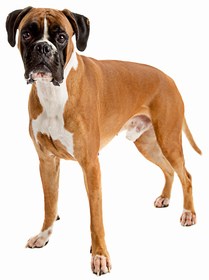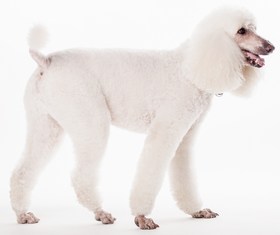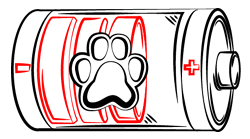
Paws ‘N’ Pups Quickview
Size
| Energy Level
| Trainability
| Paws ‘N’ Pups Rank
|
Characteristics
| Physical Characteristics: Height: 10-25” Weight: 25-70 lbs. Energy Level: Moderate – High | Colors: The Boxerdoodle is found in the following colors:
|
Health & Longevity
Average Life Span: 10-14 years
Little is known about the Boxerdoodle since this new crossbreed has only been around for a decade or two. However, plenty is known about the parent breeds: The Boxer and the Poodle. Poodles are notorious for having major health issues later in life. Whereas, Boxers are generally healthy dogs throughout their life. Most Boxerdoodles, luckily, get the majority of their health genetics from the Boxer, meaning fewer health problems and a longer, healthier life.
Hip Dysplasia – Inherited from a Poodle, this condition occurs during development before birth. The hip joint slides in and out of socket, causing friction against nerves and bones, as well as deterioration of cartilage. Over time, if left untreated, this condition can result in a permanent limp and severe, painful arthritis. It is harder to diagnose in the puppy phase, but it becomes a prevalent condition as the dog ages. Surgery is needed to correct this problem.
Progressive Retinal Atrophy – PRA is a serious disease that begins with tunnel vision, leads into night blindness, and ends in failed vision altogether. It is a gradual progression of degeneration that requires surgery to correct completely. Even then, there is a chance that surgery would be unsuccessful in curing the condition. It usually affects Boxerdoodles 8 years of age and older, but regular vet visits that begin in the puppy years can catch PRA early enough to prevent rapid retinal deterioration.
Skin Allergies – Thanks to both the Poodle and the Boxer, your Boxerdoodle could develop allergies to grass, dust, mites, and a variety of different foods, such as peanut butter and wheat. Dogs with allergies usually have to be put on a special diet to keep their allergic reactions to a minimum. Symptoms of a serious allergic reaction include itchiness, blotchy skin, hair loss, zero appetite, aggressive behavior, and skin inflammation. If left untreated, these allergic reactions can result in recurring ear infections and serious mutilation of the dog’s skin from constant scratching. Your vet can treat a reaction with antibiotics and gentle, anti-bacterial dog shampoo.
To ensure your Boxerdoodle leads a long and healthy life, schedule regular vet check-ups, invest in nutritious dog food, and help your pup get regular exercise. Healthy Boxerdoodles have a lifespan of 10-14 years.
Temperament & Train-ability
Often used as guard dogs and watchdogs, the Boxerdoodle has a multi-faceted personality. He can be serious, alert, and contemplative. He can be friendly, affectionate, and gentle. Or, he can be playful, patient, and devoted. He is a versatile pup with plenty of love and loyalty to offer. He is fiercely protective of his family, especially children he’s grown up with. But shouting, aggressive behavior, or negativity can make the Boxerdoodle sensitive, grumpy, and upset.
With strangers, Boxerdoodles are hesitant and cautious at first. They shy away from direct petting and affection if they don’t know the person. To get them accustomed to someone new, do a formal introduction where the Boxerdoodle is allowed to sniff the person without being pet or urged into acceptance. When he feels safe, he will welcome his new friends with love and a calm attitude.
Boxerdoodles are active pups who do well in open, spacious homes. However, if you live in an apartment, walk your Boxerdoodle at least twice a day, and allow him to run and play to get his energy out. Find a nice dog park. Or, let him go in your fenced-in backyard. When he comes back inside, he will be calm and relaxed—the optimum disposition for quiet bonding time on the couch.
Boxers are stubborn dogs, while Poodles are eager to please. Boxerdoodles can be both, and at the same time, so training requires patience, determination, perseverance, and a clear, concise voice. Stay consistent and strong, but be kind in your conviction. Never strike your dog or yell, because this could result in negative, aggressive behavior. Be ready with treats, praise, and encouragement when your Boxerdoodle follows a command. Plan to train and socialize your pup from an early age to nurture a well-rounded family dog.
Grooming
Poodles have short, curly hair, while Boxers have coarse fur that’s close to their skin. The Boxerdoodle can have more of one or the other, or a mix of both. Either way, these pups need to be brushed at least 3 times a week to eliminate excess hair or dander. Give your Boxerdoodle a bath once a month with gentle dog shampoo, preferably vet-recommended since these dogs are prone to skin allergies.
Boxerdoodles, thanks to their Boxer genetics, have thick toenails that grow quickly. Trim or file his nails at least bi-weekly. If you’re uncomfortable doing this yourself, ask a groomer to give your Boxerdoodle the full grooming treatment. This includes a bath, nail trim, ear cleaning, fur brushing, and teeth brushing.
Diet
Boxerdoodles have big appetites, so feed them 2 healthy nutritious meals a day. Divide 3 cups of high-quality dry kibble into these 2 meals to keep your pup fuller for longer. Avoid feeding your Boxerdoodle table scraps. These dogs are prone to overeating, so feeding them from the table could result in obesity, begging, or food stealing.
Looking for a Boxerdoodle?
 Find A Boxerdoodle Breeder |  Boxerdoodle Puppies For Sale |  Adopt A Boxerdoodle |
Cost
First check your local shelter for a Boxerdoodle that needs a new home. Adoption fees range from $200 to $350, depending on age and health, but you’ll be giving a beautiful pup the second chance at a happy home.
If you opt for a breeder, expect to pay between $1,200 to $1,500 for a puppy. Older dogs are slightly less expensive, but you also have to factor in overall care costs, such as toys, food, vet visits, vaccinations, and a spay or neuter.
Paws ‘N’ Pups Ranking
Paws ‘N’ Pups ranks every breed out of 4 with 1 being easiest to integrate into your life and 4 being the toughest – The lower the ranking the better.
Ranking takes into account a few basic factors including cost, skill level needed, high vs low maintenance and how critical regular training is to success. The Boxerdoodle ranks a 2.5 on the integration scale. When properly socialized and trained, these dogs make great family pets. However, it takes a bit of patience and determination to ensure your Boxerdoodle is a well-rounded crossbred pup. Be sure you have the time and energy to invest in one of these dogs before you make the decision to integrate them into your life.
Breeds Similar To Boxerdoodle
 Boxer |  Poodle |  Siberpoo |  Pyredoodle |




